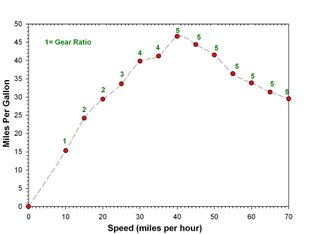Interesting application of Baye's Rule
Basically, what his article argues is this: suppose you want to determine if someone is a terrorist threat. Suppose you have some algorithm that is reasonably accurate when you apply it (say, if a person meets criteria X, Y, Z, W,.... then it follows that there is a, say, 90% probability that this person is a terrorist threat). Now you randomly apply this process to the population at large and it turns up names, say, including Ollie. So, now that Ollie has been identified, what is the probability that Ollie is indeed a terrorist threat?
Answer: pretty low; probably less than 50%. 50% is what you would get if you were to merely flip a coin with heads: "he is a terrorist" and tails: "he isn't".
Of course, one could argue is that this first mass process is really some weeding out thing so as one has a collection of people, each with a slightly higher than normal chance of being a terrorist threat, and then one could apply more expensive tests to this group, knowing that the "false alarm" rate is going to be very high.
Anyway, here goes with the article:
http://www.counterpunch.org/rudmin05242006.html
Why Does the NSA Engage in Mass Surveillance of Americans When It's Statistically Impossible for Such Spying to Detect Terrorists?
By FLOYD RUDMIN
The Bush administration and the National Security Agency (NSA) have been secretly monitoring the email messages and phone calls of all Americans. They are doing this, they say, for our own good. To find terrorists. Many people have criticized NSA's domestic spying as unlawful invasion of privacy, as search without search warrant, as abuse of power, as misuse of the NSA's resources, as unConstitutional, as something the communists would do, something very unAmerican.
In addition, however, mass surveillance of an entire population cannot find terrorists. It is a probabilistic impossibility. It cannot work.
What is the probability that people are terrorists given that NSA's mass surveillance identifies them as terrorists? If the probability is zero (p=0.00), then they certainly are not terrorists, and NSA was wasting resources and damaging the lives of innocent citizens. If the probability is one (p=1.00), then they definitely are terrorists, and NSA has saved the day. If the probability is fifty-fifty (p=0.50), that is the same as guessing the flip of a coin. The conditional probability that people are terrorists given that the NSA surveillance system says they are, that had better be very near to one (p_1.00) and very far from zero (p=0.00).
The mathematics of conditional probability were figured out by the Scottish logician Thomas Bayes. If you Google "Bayes' Theorem", you will get more than a million hits. Bayes' Theorem is taught in all elementary statistics classes. Everyone at NSA certainly knows Bayes' Theorem.
To know if mass surveillance will work, Bayes' theorem requires three estimations:
1) The base-rate for terrorists, i.e. what proportion of the population are terrorists.
2) The accuracy rate, i.e., the probability that real terrorists will be identified by NSA;
3) The misidentification rate, i.e., the probability that innocent citizens will be misidentified by NSA as terrorists.
No matter how sophisticated and super-duper are NSA's methods for identifying terrorists, no matter how big and fast are NSA's computers, NSA's accuracy rate will never be 100% and their misidentification rate will never be 0%. That fact, plus the extremely low base-rate for terrorists, means it is logically impossible for mass surveillance to be an effective way to find terrorists.
I will not put Bayes' computational formula here. It is available in all elementary statistics books and is on the web should any readers be interested. But I will compute some conditional probabilities that people are terrorists given that NSA's system of mass surveillance identifies them to be terrorists.
The US Census shows that there are about 300 million people living in the USA.
Suppose that there are 1,000 terrorists there as well, which is probably a high estimate. The base-rate would be 1 terrorist per 300,000 people. In percentages, that is .00033% which is way less than 1%. Suppose that NSA surveillance has an accuracy rate of .40, which means that 40% of real terrorists in the USA will be identified by NSA's monitoring of everyone's email and phone calls. This is probably a high estimate, considering that terrorists are doing their best to avoid detection. There is no evidence thus far that NSA has been so successful at finding terrorists. And suppose NSA's misidentification rate is .0001, which means that .01% of innocent people will be misidentified as terrorists, at least until they are investigated, detained and interrogated. Note that .01% of the US population is 30,000 people. With these suppositions, then the probability that people are terrorists given that NSA's system of surveillance identifies them as terrorists is only p=0.0132, which is near zero, very far from one. Ergo, NSA's surveillance system is useless for finding terrorists.
Suppose that NSA's system is more accurate than .40, let's say, .70, which means that 70% of terrorists in the USA will be found by mass monitoring of phone calls and email messages. Then, by Bayes' Theorem, the probability that a person is a terrorist if targeted by NSA is still only p=0.0228, which is near zero, far from one, and useless.
Suppose that NSA's system is really, really, really good, really, really good, with an accuracy rate of .90, and a misidentification rate of .00001, which means that only 3,000 innocent people are misidentified as terrorists. With these suppositions, then the probability that people are terrorists given that NSA's system of surveillance identifies them as terrorists is only p=0.2308, which is far from one and well below flipping a coin. NSA's domestic monitoring of everyone's email and phone calls is useless for finding terrorists. [...]
Note: This article goes on to discuss some politics, which I don't want to get into on this particular blog. My other blog: http://blueollie.blogspot.com doesn't shy away from this discussion.


